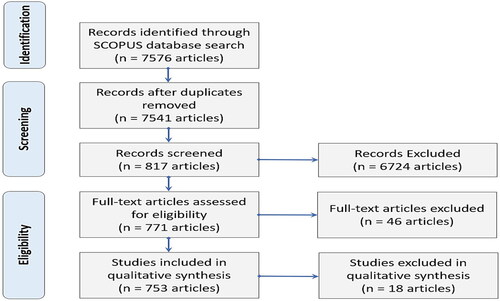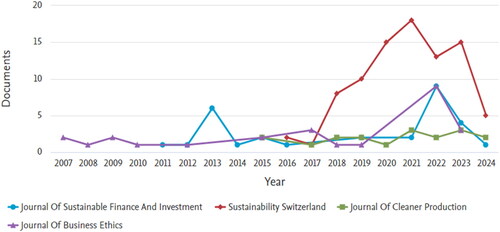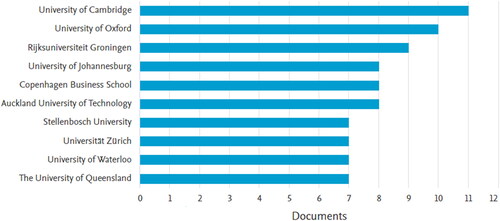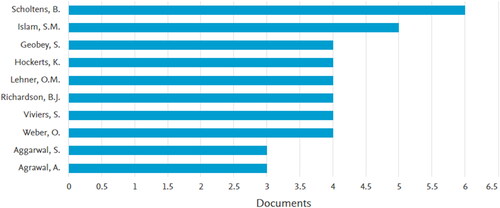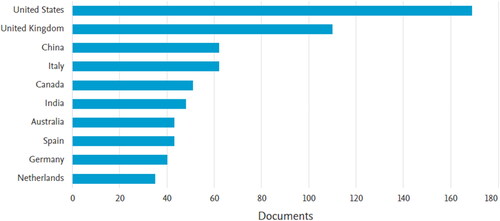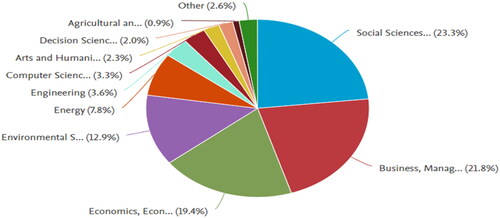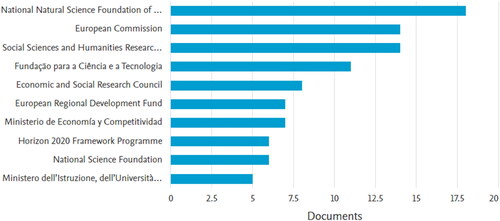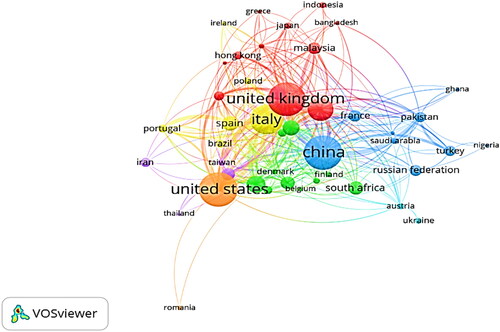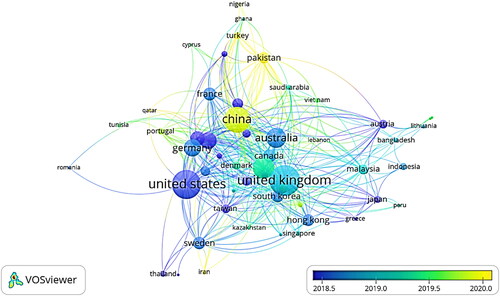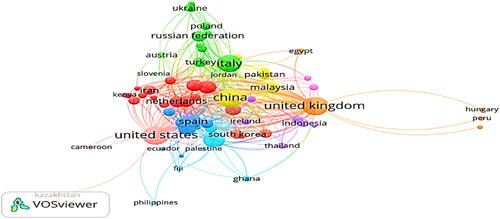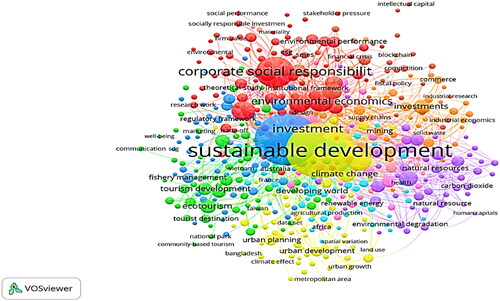Abstract
The current study intends to understand the spectrum of existing scientific literature on Impact Investing, explore the publication credentials of that literature in the form of bibliometrics, and investigate the future scope for research in the area of impact investing. We have used the visualization tool VOSviewer to analyze the bibliometric data collected from the Scopus database. ‘Sustainable development’ was identified as the most used keyword in the documents, followed by ‘corporate social responsibility’, ‘investment’, and ‘environmental performance’. The United States was the leading contributing country followed by the UK, China, Italy, Canada, and India. Based on the systematic review of 753 journal articles, we have identified five distinct research areas in the field of impact investing. The top five research clusters are sustainable development research, sustainability research, corporate social responsibility research, Sustainable investment research, and environmental economics research. Our results revealed a dearth of focus among researchers in identifying impact investing either as a standalone concept or as a concept that drives better performance in organizations. Hence, we propose some promising areas of impact investing research. They are sustainable finance, firm performance, tourism, and climate change research. The output of this research has implications for researchers, practitioners, policymakers, and academia since it pinpoints the popular and promising clusters of research in the field of impact investing. Our study is unique and original in the sense that it covers a more comprehensive inclusion, and exclusion criteria as well as keyword combinations and thus, it provides better directions for future research in the field.
REVIEWING EDITOR:
SUBJECTS:
Introduction
Research on the topic of ‘Impact investing’, particularly in the domain of finance, management and social sciences has gained momentum since 2015. The concept of impact investing is now the catchword in every business and investment firm. The term impact investing is conceived as an investment strategy that essentially contributes to social and environmental goals along with the economic goals of the firm. Existing literature reveals that expert investors and female investors exhibit favorable attitudes towards impact investment options and tend to invest more in social funds (De Amicis et al., Citation2020). According to the annual impact investor survey of the Global Impact Investing Network (GIIN), the market size of ESG investing has grown from US$ 502 billion in 2018 to US$ 715 billion in the year 2020 (The Global Impact Investing Network [GIIN], Citation2020). The survey also reported that ‘ESG investors intend to contribute to the industry through six areas of action like identity, behaviours and expectations products, tools and services, education and training, and policy and regulation over the next 5 years’. Impact investing can be defined as a form of investment that is made into companies, organizations, and funds to generate social and environmental impact alongside a financial return’ (GIIN, Citation2016).
Höchstädter and Scheck (Citation2015) tried to understand the definitional, terminological, and strategic aspects of impact investing in published literature and pointed out the similarities and inconsistencies in definitions, terminologies and strategic aspects. Islam (Citation2021) offers a more up-to-date review of impact investing; however, their research design is very different from ours, using a far more diffuse set of search terms, many of which are arguably at the edge of impact investing. Migliavacca et al. (Citation2022) conducted a bibliometric review using a keyword search analysis of the Elsevier Scopus database to map the academic contributions to impact investing and highlighted the most significant research streams and trends. They have analyzed 115 scholarly articles published between October 2021 and 2009 using visualization technique and suggested areas that require more investigation in the field. Though, we have also used similar methodology of adopting the Scopus database for our investigation, we have included a wider spectrum of research articles spanning over 17 years from the year 2007 to 2024 in our bibliometric exploration and thus, we could cover 753 research articles in our systematic review. We have also tried to differentiate our study from the extant literature by using an all-encompassing list of keywords, and a more comprehensive inclusion and exclusion criteria for our investigation. Scopus database is used for this study since it covers a large number of journals in its scope. Moreover, the popularity of the Database among researchers across the world also motivated the researcher to adopt Scopus Database results for our study.
The rest of the paper is presented as follows. Section two explains the research questions and objectives of the study, section three detailed the process and methodology followed for our bibliometric analysis, section four narrates the inclusion and exclusion criteria adopted, section five presents the results and discussion and section six provides the conclusion and implications of the study.
Research questions and objectives
Research questions and objectives play a significant role in determining the quality of evidence as well as the data that one can capture during the systematic review process (Harris et al Citation2018). Research questions for quantitative inquiries often resort to structured processes such as PICO (population, intervention, comparison, and outcome) model. However, according to Cooke et al. (Citation2012), qualitative inquiries often use an adapted version of this model, like SPICE (Setting, perspective, intervention, comparison, evaluation), or SPIDER (sample, phenomenon of interest, design, evaluation, research type), to better explain the research question under consideration. In the field of social sciences, the most popular model in systematic review is PRISMA (Preferred Reporting Items for Systematic Reviews and Meta-Analysis). It is a checklist for authors to ensure that their systematic review is more transparent and complete (Moher et al., Citation2009). Following this argument, the author decided to adopt the PRISMA model for this bibliometric analysis. The purpose of bibliometric analysis is not just an analysis of the existing literature, rather it should point out some research questions to be addressed by the future researchers and to provide them with various research streams (Patel & Siddiqui, Citation2023; Patel, Migliavacca, et al., Citation2022; Patel, Goodell, et al., Citation2022). Accordingly, the current study aims to address the following research questions: What is the popularly used scientific literature addressing the topic of impact investing? What are the key emerging research trends in impact investing? What are the key bibliometric credentials of literature on impact investing to date? and, what is the future scope for research in the area of impact investing?
Inclusion and exclusion criteria
To provide an overview of the scientific literature on impact investing, we have done a bibliometric analysis. To design the inclusion and exclusion criteria, we have used multiple filters during the data collection process. Primarily, only those studies captured in the Scopus database were considered for this study. Literature from all the sources other than the Scopus database were excluded in the first stage. The second inclusion criterion applied was the type of publication. Literature in the form of research articles alone was included in this analysis, while we have excluded other types of articles such as conference proceedings, book chapters, books, PhD theses, popular articles like newspaper articles, blogs, posts, social media reports, editorial, opinions, etc. Another inclusion criterion applied in this study was the field of discipline where the literature is published. We have included only those literature from disciplines such as social sciences, business and management, finance, economics, and econometrics, and excluded literature available in science, engineering, environmental sciences, and medical fields. Another inclusion criterion used in the current study is the use of keywords. Only those studies with keywords such as impact investing, sustainable investing, green investing, and responsible investing were included in our literature review.
Methodology
To explore the future scope for research in the area of impact investing, we have used a bibliometric analysis. The concept of bibliometrics was first used by Pritchard (Citation1969). The term bibliometrics refers to the application of statistical analysis to publication details such as citations, keywords, indexing etc. To attain the objectives of the current study we have used Scopus database of Elsevier, which is the largest abstract and citation database. It provides a comprehensive database of peer-reviewed literature including journals, books and conference proceedings (Elsevier, Citation2022). The researcher has followed the methodology of Constantin-Marius (Citation2020) to design the entire study. At first, we have selected the key words to be explored. We have used only those literature with the key words ‘ESG and investing or impact and investing or sustainable and investing or responsible and investing and or green and investing’ to retrieve the literature from the database. The sample was initially consisted of 7576 articles. We then filtered the data by using several criteria like year of publication, language of publication, disciplines etc., to limit the literature to a feasible set of data. Only those research papers published in English language were selected for our review. We have eliminated papers published in disciplines other than social science, business and management, finance, economics and econometrics from out review list. Accordingly, we have selected 817 research papers published in journals included in the Elsevier Scopus Database from the year 2007 to 2024. So the timeframe for this research is 17 years spanning from 2007 to 2024. The abstracts of these papers were critically examined by the researcher to decide whether to include or exclude them, depending on their relevance in the field of study, by looking at the content and keywords given in the abstracts. Accordingly, the researcher has selected 753 published research papers from the list of 817 papers for full paper screening. Again, the researcher critically evaluated the content quality of these papers by going through every article in the selected list. Content quality is ensured by looking at various parameters like content in the introduction, theoretical framework, materials and methods, results discussion, and conclusion sections of the papers. The current study used science mapping which is popularly known as visualizing bibliometric networks, to analyze the document bibliometric obtained from the Elsevier Scopus Database. We have used the VOSviewer software for constructing and visualizing bibliometric networks based on citations, bibliographic coupling, keyword occurrence as well as co-author relations. We have used the text mining functionality of VOSviewer software to visualize the keyword co-occurrence networks extracted from the literature. We have also used the functionalities of Excel Spreadsheet for preparing the Tables based on the citations and keyword occurrence in our study, apart from the figures representing the network visualizations. The process flow of methodology is given in .
Results and discussion
The data were exported to an Excel file and further analysis of the bibliometrics was done using Microsoft Excel and VOSviewer. Visualization of bibliometric networks has gained the attention of researchers since the beginning of bibliometric research. It offers a powerful way of analyzing different bibliometric networks including networks of citation relations between publications, networks of citation relations between journals, networks of co-authorship relations between researchers, and networks of co-occurrence relations between keywords (Van Eck & Waltman, Citation2014).
Preliminary analysis
Since 2007, onwards if we analyze the documents per year by source, a maximum number of documents are available in the journal ‘Sustainability’ in the year 2021, followed by the Journal of Sustainable Finance and Investment, ‘Journal of Cleaner Production, and ‘Journal of Business Ethics’ ().
The top 10 affiliating universities/institutions and the count of documents per institution is given in . The University of Cambridge is the top affiliating institution which published 11 articles in Scopus-indexed journals on the topic ‘impact investing’, followed by the University of Oxford with 10 documents and Rijksuniversiteit Groningen with 9 documents on the topic ().
Documents by the contributing authors are given in . The highest contribution came from Scholtens with 6 documents. Islam contributed 5 articles on the topic, while 6 other authors contributed 4 documents each in the area.
shows the results of documents by country of publication. The United States accounted for more than 169 documents, followed by the UK with contributions of 110 documents. China and Italy accounted for 62 documents each, Canada contributed 51 documents while India contributed 48 documents on impact investing.
Based on the subject area, it is revealed that most of the publications are from social sciences (23%), while business management and accounting accounted for almost 22% of the documents. Nearly 19% of the publications are from economics and econometrics, while 12% are from environmental science. The other subjects covered are energy, engineering, computer science, arts and humanities, decision science, agricultural and biological sciences and others including psychology, medicine etc. ().
The top 10 sponsoring institutions are given in . It includes the National Natural Science Foundation, the European Commission, the Social Science and Humanities Research Council of Canada, Fundacao Para a Ciencia e a Tecnologia, and the Economic and Social Research Council.
Data visualization
There are different approaches to visualizing bibliometric networks. The popularly used approaches are distance-based, graph-based, and timeline-based (Van Eck & Waltman, Citation2014). Circular visualizations (Börner et al., Citation2012) and self-organizing maps (Skupin et al., Citation2013) are among the other approaches used for visualization of networks. In the distance–based approach, the distance between nodes is indicative of their relatedness. Node locations are decided based on either the multi-dimensional scaling technique (Borg & Groenen, Citation2005) or the VOS technique (Van Eck & Waltman, Citation2010). Visualization of bibliometric networks in the current study is done using VOSviewer software, which follows distance–based approach for visualization using the VOS (Visualization Of Similarities) technique (Van Eck & Waltman, Citation2014). A bibliometric network generally consists of nodes and edges. However, the VOS viewer presents only the nodes and does not present the edges between the nodes. The nodes can represent publications, journals, countries, researchers, or even keywords. Since VOSviewer follows a distance-based approach to the visualization of networks, it is more suitable for larger networks. The popular types of analysis include citation relations such as direct citation relations, co-citation relations (Small, Citation1973) and bibliographic coupling relations, keyword occurrence and co-occurrence relations, and co-author relations (Van Eck & Waltman, Citation2014). Since these networks are weighted networks, they can be used to indicate not only the relation between two nodes but also to reveal the strength of that relation. The bigger the node of the network, the higher the number of representing the variable measured. The distance between two nodes in the network represents the strength of the relationship between them (frequently coming together in documents). Strongly related nodes are located close to each other while weakly related nodes are located far away from each other (Van Eck & Waltman, Citation2014).
In visualization networks in VOSviewer, nodes by default are assigned to clusters. Clusters are sets of strongly associated nodes. Every node in the network is assigned to one particular cluster, based on a resolution parameter. VOSviewer uses different colours in the network to identify the cluster to which each node is attached (Van Eck & Waltman, Citation2014). From the visualization network representing country-wise citations we can conclude that, based on the number of citations, the United States comes first, followed by the UK, China, and Italy ( and ). The distance between the nodes representing the UK and Italy is very small, hence it is inferred that these countries often collaborate in their research on impact investing. The colour of the node indicates the average number of citations per year for publication from each country.
When we look at the co-author country, it is evident that co-authorship is shared predominantly among Italy, Turkey, Russia, Poland, Ukraine, and Australia. Co-authorship is also shared among the Netherlands, Kenya, Iran, and Slovenia. Collaboration exists between China, Malaysia, and Pakistan. UK collaborates in their research on ESG investing with Hungary, Peru, and Egypt ().
The most occurring keywords are given in the following network (). The most frequently occurring keywords include sustainable development, corporate social responsibility, sustainable investment, and environmental economics. This is indicative of the fact that the researchers generally perceive impact investing through the lens of sustainable developmental efforts or corporate social responsibility initiatives. It may also be interpreted as a lack of focus among researchers in identifying impact investing either as a standalone concept or as a concept that drives better performance in organizations. However, researchers across periods have given more focus on the concept of impact investing as a construct that meets the requirements of sustainable development, corporate social responsibility, and environmental performance.
Networks of co-occurrence of keywords give the number of publications in which both keywords appear together in the title, abstract, or keyword list (Van Eck & Waltman, Citation2014). In our study, the keyword ‘sustainable development’ is reported to have the highest number of occurrences with 688 such evidence. It shows 494 links (number of co-occurrences – the keyword ‘sustainable development’ has co-occurred 494 times with other keywords) as well as a total link strength of 3759 (frequency of publications where such co-occurrences have happened). It was followed by the keywords sustainability, investment, environmental economics, and CSR with total link strengths of 3007, 1124, 912, and 714. The threshold of analysis was set at a minimum number of occurrences of a keyword as five. Out of the total 6754 keywords, there were 502 that met the threshold limits set. Based on keyword occurrences we could identify five different streams of research in the field of impact investing. They are sustainable development research, sustainability research, corporate social responsibility research, Sustainable investment research, and environmental economics research. Thus, it is concluded that the concept of impact investing is popularly used in extant literature in these four contexts. So, researchers should focus on other aspects of impact investing to contribute to the existing literature ().
Table 1. Analysis of co-occurrence (unit of analysis: all keywords).
When we analyzed the documents with the number of citations as the weight, we found that the document Evans, S. (2014) has the highest number of citations (331); however, the document has only one link. The threshold of analysis was set at a minimum number of citations per document as ten. Out of the total 1384 documents, there were 533 which met the threshold limits set. Based on the network weight ‘number of links’, it is observed that the document Lai, A. (2016) establishes the highest number of links (8) followed by documents Melander, L. (2017), Helfaya, A. (2017) and Lee, K. H. (2016b) with 7 links each ().
Table 2. Analysis of citations (unit of analysis: documents).
The next analysis was done using country as the unit of analysis. Threshold of analysis was set at minimum number of documents per country of 10, and minimum number of citations per country of 10. Out of the total 132 countries, 45 countries met the threshold limits set. When the total link strength is taken as the network weight, it was observed that the UK produced 167 documents with total citations of 3544 and a total link strength of 186, followed by China with a total link strength of 171, Italy with 164 total link strength, USA with 128 link strength and Australia with 121 total link strength. When the number of citations was assigned as the network weight, it was again the UK that led in the criteria followed by the USA, China, Italy, and Australia ().
Table 3. Analysis of citations (unit of analysis: country).
Finally, we have analyzed citations by taking organizations as the unit of analysis. The threshold of analysis was set at the minimum number of documents per organization at three, and the minimum number of citations per organization at three. Out of the total 3002 organizations, there were 7 that met the threshold limits set. In terms of citations, the School of Management, Northwestern Polytechnical University, Xi’an, China tops the list with 81 citations, followed by the Department of Business Administration, Ilma University, Karachi, Pakistan with 61 citations, the Department of Economics, University of Wah, Quaid Avenue, Wah Cantt, Pakistan with 38 citations, and Faculty of Economics Administrative and Social Sciences, Istanbul Gelisim University, Istanbul, Turkey with 25 citations ().
Table 4. Analysis of citations (unit of analysis: organization).
Conclusion
The topic of impact investing and related concepts is getting more popular among researchers as they appear increasingly and more frequently in research articles. On the initial search itself, the researcher could gather more than 7000 research articles on the related topics. Citations of these documents show a steep increase from the year 2017 to 2021. The top journals publishing on this topic are Sustainability and Journal of Cleaner Production. Wageningen University & Research is the top affiliating institution, having published articles in Scopus-indexed journals on the topic of impact investing, followed by the University of Leeds and Monash University. Sustainable development was identified as the most appearing keyword in all the documents followed by corporate social responsibility, investment, and environmental performance. The United States was the leading contributing country followed by the UK, China, and Australia. Though we have done an extensive review of the literature available on the topic, we could cover only the Scopus database in our research. Selection of research papers published in other prominent databases like Web of Science, google Scholar, and Ebsco may provide a more comprehensive result. However, within this limited scope of Scopus Database our study contributes to the existing literature by identifying five clusters of impact investing research. The clusters identified are sustainable development research, sustainability research, corporate social responsibility research, Sustainable investment research, and environmental economics research. The results of this research can help the researchers, academia as well as practitioners by providing a better understanding of the related topics investigated by the extant literature. The present study extensively researches the keywords covered in impact investing literature. The results revealed that limited research has been undertaken specifically on the topic of impact investing. Most of the studies have mentioned the term as part of sustainable development or corporate social responsibility efforts of organizations. Studies focusing impact investing as a business strategy are yet to be initiated. Future researcher can identify this as the research gap existing in this field. We failed to identify any previous researches investigating the marketing aspects of impact investing. There is also dearth of studies focusing on the role of impact investing on human resources functions. Thus, future researchers should focus more on the marketing aspects of impact investing, such as how impact investing influences the marketing strategy of firms and whether impact investing leads to better brand image, brand loyalty and brand equity. Studies should also be undertaken to understand whether impact investing influences job satisfaction, employee retention and other human resources functions in organizations. Further researches can focus more on the strategic aspects of impact investing in business decisions. This research has implications for researchers, practitioners, policymakers, and academia since it pinpoints the popular and promising clusters of research in the field of impact investing. As the study suggests, the corporate policy makers should focus more on the marketing, Human resource, and strategic aspects of impact investing, so as to enable the business organization to leverage on it.
Acknowledgements
The author acknowledges the services extended by Dr. Makesh K G, Assistant Professor, Government Arts and Science College Uduma, Kasaragod in revising and redrafting the manuscript based on peer review comments.
Disclosure statement
No potential conflict of interest was reported by the author(s).
Additional information
Notes on contributors
Minimol M C
Dr. Minimol M. C is currently working as an Associate Professor and Head in the Department of Commerce & International Business of the Central University of Kerala. She has over sixteen years of experience in teaching, and research in commerce and management studies. Having published more than 60 articles in refereed journals, including Scopus indexed and ABDC ranked journals, she is strongly committed to social research. Her latest works include gender diversity and firm performance, entrepreneurial competencies and social entrepreneurship, cause related marketing, corporate social responsibility and firm performance, and Foreign Direct Investment, institutional quality and sustainability.
References
- Borg, I., & Groenen, P. J. F. (2005). Modern multidimensional scaling (2nd ed.). Springer.
- Börner, K., Klavans, R., Patek, M., Zoss, A. M., Biberstine, J. R., Light, R. P., Larivière, V., & Boyack, K. W. (2012). Design and update of a classification system: The UCSD map of science. PloS One, 7(7), 1. https://doi.org/10.1371/journal.pone.0039464
- Constantin-Marius, A. (2020). Sustainable finance: A bibliometric analysis of the scientific literature. International Journal of Management and Applied Sciences, 6(6), 21–11.
- Cooke, A., Smith, D., & Booth, A. (2012). Beyond PICO: The SPIDER tool for qualitative evidence synthesis. Qualitative Health Research, 22(10), 1435–1443. https://doi.org/10.1177/1049732312452938
- De Amicis, L., Binenti, S., Maciel Cardoso, F., Gracia-Lázaro, C., Sánchez, Á., & Moreno, Y. (2020). Understanding drivers when investing for impact: An experimental study. Palgrave Communications, 6(1), 86. 2020 https://doi.org/10.1057/s41599-020-0447-y
- GIIN. (2016). Impact investing trends evidence of a growing industry. https://thegiin.org/research/publication/impact-investing-trends.
- Harris, J. L., Booth, A., Cargo, M., Hanne, s K., Harden, A., Flemming, K., Garside, R., Pantoja, T., Thomas, J., & Noyes, J. (2018). Cochrane Qualitative and Implementation Methods Group guidance series paper 2: Methods for question formulation, searching, and protocol development for qualitative evidence synthesis. Journal of Clinical Epidemiology, 97, 39–48. https://doi.org/10.1016/j.jclinepi.2017.10.023
- Höchstädter, A. K., & Scheck, B. (2015). What’s in a name: An analysis of impact investing understandings by academics and practitioners. Journal of Business Ethics, 132(2), 449–475. https://doi.org/10.1007/s10551-014-2327-0
- Islam, S. M. (2021). Impact investing in social sector organisations: A systematic review and research agenda. Accounting & Finance, 62(1), 709–737. https://doi.org/10.1111/acfi.12804
- Migliavacca, M., Patel, R., Paltrinieri, A., & Goodell, J. W. (2022). Mapping impact investing: A bibliometric analysis. Journal of International Financial Markets, Institutions and Money, 81, 101679. https://doi.org/10.1016/j.intfin.2022.101679
- Moher, D., Liberati, A., Tetzlaff, J., & Altman, D. G. (2009). Preferred reporting items for systematic reviews and meta-analyses: the PRISMA statement. PLoS Medicine, 6(7), e1000097. https://doi.org/10.1371/journal.pmed.1000097
- Patel, R., & Siddiqui, A. (2023). Banking service quality literature: A bibliometric review and future research agenda. Qualitative Research in Financial Markets, 15(5), 732–756. https://doi.org/10.1108/QRFM-01-2022-0008
- Patel, R., Migliavacca, M., & Oriani, M. E. (2022). Blockchain in banking and finance: A bibliometric review. Research in International Business and Finance, 62(C), 101718. https://doi.org/10.1016/j.ribaf.2022.101718
- Patel, R., Goodell, J. W., Oriani, M. E., Paltrinieri, A., & Yarovaya, L. (2022). A bibliometric review of financial market integration literature. International Review of Financial Analysis, 80(C), 102035. https://doi.org/10.1016/j.irfa.2022.102035
- Pritchard, A. (1969). Statistical bibliography or bibliometrics? Journal of Documentation, 25, 348–350.
- Elsevier. (2022). About Scopus. https://www.elsevier.com/en-in/solutions/scopus.
- Skupin, A., Biberstine, J. R., & Börner, K. (2013). Visualizing the topical structure of the medical sciences: A self-organizing map approach. PloS One, 8(3), e58779. https://doi.org/10.1371/journal.pone.0058779
- Small, H. (1973). Co-citation in the scientific literature: A new measure of the relationship between two documents. Journal of the American Society for Information Science, 24(4), 265–269. https://doi.org/10.1002/asi.4630240406
- The Global Impact Investing Network. (2020). Annual impact investor survey. https://thegiin.org/research/publication/impinv-survey-2020.
- Van Eck, N. J., & Waltman, L. (2010). Software survey: VOSviewer, a computer program for bibliometric mapping. Scientometrics, 84(2), 523–538. https://doi.org/10.1007/s11192-009-0146-3
- Van Eck, N. J., & Waltman, L. (2014). Visualizing bibliometric networks. In Y. Ding, R. Rousseau, & D. Wolfram (Eds.), Measuring scholarly impact: Methods and practice (pp. 285–320). Springer.

